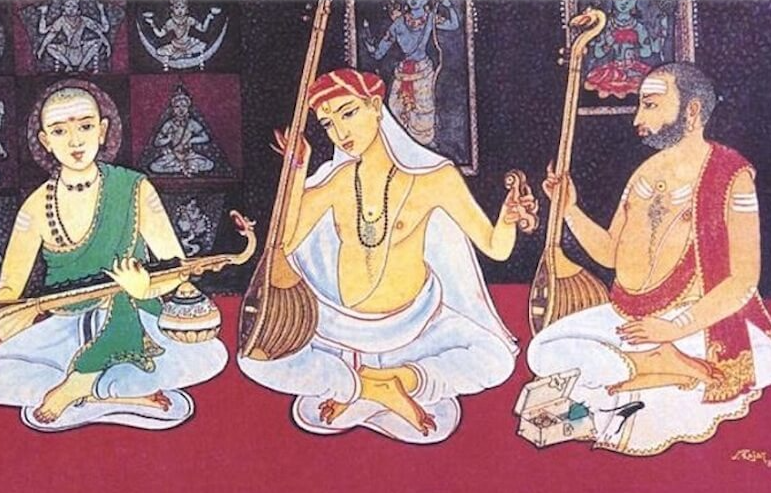Evolution of the Indian Music System (GS Paper 1, Art & Culture)

Why in News?
- A recent study revealed that chimps can dance in tune with rhythmic music, suggesting an evolutionary link in our sense of rhythm.
- Archaeological evidence, like a 40,000-year-old flute made from animal bone, offers insights into the origins of human musical expression.
Findings of the Recent Study
- Origin of Music in Humans: Singing likely began after speech developed during the Old Stone Age, around 2.5 million years ago.
- Playing musical instruments started about 40,000 years ago, with the discovery of a seven-holed flute made from animal bone.
- Musical Notations: Indian musical notes ('sa, re, ga, ma, pa, da, ni') originated during Vedic times (1500-600 BCE), forming the foundation of Indian classical music.
- In Europe and the Middle East, spaced notations ('do, re, mi, fa, sol, la, ti') developed independently around the 9th century BCE.
Evolution of Indian Music System
Ancient Period:
Sama Veda:
- The roots of Indian music trace back to the Sama Veda, harmonizing slokas with music. Narada Muni introduced music to humanity and imparted knowledge of Naada Brahma, the cosmic sound.
Development of Vedic Music:
- Vedic music evolved from single notes to incorporating two and three notes, leading to the establishment of the seven basic notes (sapta swaras).
- Vedic hymns were integral to religious rituals such as yagas and yagnas, where they were sung and danced to the accompaniment of string and percussion instruments.
Early Tamil Contributions:
- Scholars like Ilango Adigal and Mahendra Verma significantly contributed to ancient Tamil musical ideas, documented in texts like Silappadikaram and Kudumiyamalai inscriptions.
- Ancient Tamil treatises, such as Karunamrita Sagara, provided insights into ragas represented by various 'pans' and the understanding of sthayi (octave), srutis, and swara sthanas.
Medieval Period:
Unified Musical System:
- Until the 13th century, India had a cohesive musical system based on saptaswaras, octaves, and sruti (microtones).
Introduction of Terms:
- Haripala coined the terms Hindustani and Carnatic music, marking the distinction between northern and southern traditions.
Impact of Muslim Rule:
- Muslim rulers in North India brought Arabian and Persian musical influences, broadening Indian music's scope.
- This interaction expanded the variety of instruments and styles.
Influence of Bhakti Movement:
- Saint singers and poets like Purandara Dasa systematized talas and contributed to devotional song compositions.
- The 7th century onwards saw the rise of numerous saint singers and religious poets across India, including Purandara Dasa in Karnataka, who systematized talas (rhythmic cycles) and contributed significantly to devotional song compositions.
Emergence of Musical Forms:
- Forms like Khayal, Thumri, and Tarana gained prominence, enriching Hindustani classical music.
Gharanas:
- Distinct musical traditions, or gharanas, like Agra, Gwalior, Jaipur, Kirana, and Lucknow, developed unique stylistic elements.
- Gharanas flourished, each contributing unique stylistic elements to Hindustani music.
Modern Period:
Legendary Musicians:
- Icons like Ustad Alladia Khan, Pt. Omkarnath Thakur, Pt. Vishnu Digambar Paluskar, and Ustad Bade Ghulam Ali Khan enriched Hindustani music with their innovations.
- These musicians became the torchbearers of their traditions, passing on their knowledge to future generations.
Preservation through Notation:
- Notation systems preserved and made musical compositions accessible across generations.
- The advent of notation systems ensured the preservation and accessibility of musical compositions across generations, safeguarding invaluable musical heritage.
Systematization of Hindustani Ragas:
- Pandit Vishnu Narayan Bhatkhande systematized Hindustani Ragas under the 'Thaat' system, establishing a structured foundation for musical education.
- His work provided a comprehensive framework for understanding and teaching Hindustani music.
Scholarly Compositions:
- Scholarly forms like Kritis, Swarajatis, Varna, Pada, Tillana, Jawali, and Ragamalikas evolved in sophistication, drawing inspiration from ancient prabandhas.
- These compositions drew inspiration from ancient prabandhas while evolving in musical and lyrical sophistication.
Conclusion
- Indian music has evolved through ancient, medieval, and modern periods, influenced by cultural exchanges and regional developments, creating a rich and diverse art form.
- The continuity and adaptability of Indian music have allowed it to thrive and remain relevant, making it an integral part of India's cultural heritage.
- The evolution of Indian music is a testament to its resilience and the profound cultural exchanges that have shaped it over millennia.


